Mechanics of Fate Reforged
Table of Contents
Bolster
Prowess
Delve
Dash
Ferocious
Manifest
Hybrid Mana
Modal Enters-the-Battlefield Abilities

Welcome back to Tarkir! And we mean really back, as the Fate Reforged set take place over a thousand years before the events of Khans of Tarkir. The five clans you got to know in the last set are still here, but now instead of revering the qualities of extinct dragons, the clans are revering and battling very-much-alive dragons!
In addition to the five clans, five dragon broods appear in Fate Reforged. Each brood is led by a mighty dragon, particularly revered by one of the five clans. Cards closely associated with one of the clans or one of the dragon broods each have a unique icon that appears in their text boxes. These icons don't affect game play.

Bolster
The Abzan (the white-black-green clan) tries to emulate the endurance of the dragon. To survive, the Abzan make sure there are no weak links in their defenses. In this set, they do this using the new bolster mechanic. Bolster is a keyword action, and it is always followed by a number.
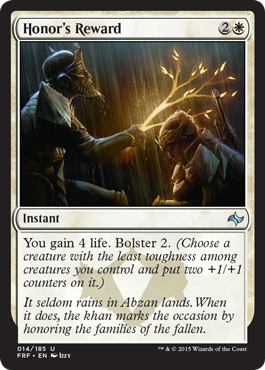
To bolster, first find the creature you control with the least toughness. If there's a tie, choose one of those creatures. Then, put a number of +1/+1 counters on it equal to the bolster number. Bolster doesn't target any creature, and you don't determine which creature is getting the counters until you're taking the bolster action.
So suppose you control two 3/3 creatures and a 2/2 creature and you cast Honor's Reward. In response, your opponent destroys your 2/2 creature. To resolve Honor's Reward, you gain 4 life, and then you bolster 2. Since both of your creatures are tied for the least toughness, you choose one of them. It gets two +1/+1 counters, and you have a shiny new 5/5 creature.

Prowess
Prowess returns in this set as the Jeskai (the blue-red-white clan) mechanic. It hasn't changed since its appearance in Khans of Tarkir.
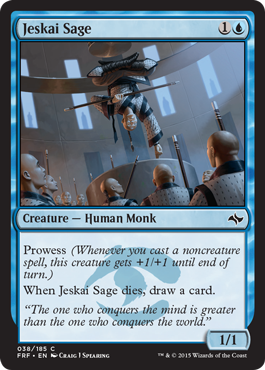
The Jeskai believe emulating the cunning of the dragon will lead them to enlightenment and victory. Prowess is a triggered ability that is cunning indeed, turning your noncreature spells into powerful combat bonuses.
Creature spells won't cause prowess to trigger, even if those spells have other card types, such as an artifact creature spell. Instants work particularly well, as they become combat tricks that boost your attacking or blocking creatures in addition to whatever they normally do.
When prowess triggers, it goes on the stack on top of the spell that caused it to trigger, meaning it will resolve first. Once prowess has triggered, it doesn't matter what happens to the noncreature spell. If it gets countered, prowess will still resolve, as long as the creature with prowess is still around.

Delve
The Sultai (the black-green-blue clan) have been using every resource available to them since time immemorial. They identify with the ruthlessness of the dragon. Delve is a returning mechanic that uses the dead to fuel powerful spells. It hasn't changed since its appearance in Khans of Tarkir.
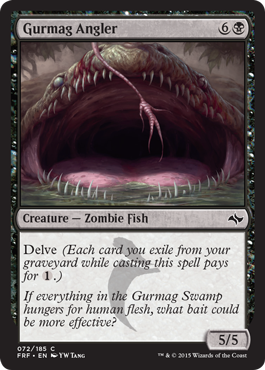
Spells with delve may have a high mana cost, but you usually won't be paying all of it with mana. As you're paying for a spell with delve, you can exile cards from your graveyard. Each card you exile this way pays for 1. So, if you're casting Gurmag Angler, you can pay 6B. You can also exile four cards from your graveyard and pay 2B, which is a pretty good deal. If you have six cards in your graveyard, you can exile them all and get Gurmag Angler for only B!
Delve can't pay for any colored mana in the spell's mana cost. Also, you can't exile more cards than the amount of colorless mana in the mana cost. So you couldn't exile more than six cards while casting Gurmag Angler, even if for some reason you wanted to. If the spell with delve is countered, you don't get those cards back from exile, just as you don't get a refund on your mana.

Dash
The Mardu (the red-white-black clan) prize the speed of the dragon, relentlessly attacking until their foes crumble. Their signature mechanic is dash.
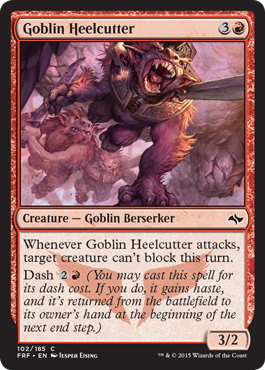
Dash is an alternative cost found on creature spells. As you cast a spell with dash, you can pay its dash cost instead of paying its mana cost. If you do, the creature will have haste, so it can attack that turn. At the beginning of the next end step, you'll return the creature from the battlefield to its owner's hand.
If you choose to pay the dash cost, you're still casting the spell, so it goes on the stack and can be countered. Dash doesn't change when you can cast creature spells—usually only during your main phase. If you cast a creature spell using its dash cost, it will return to your hand only if it's still on the battlefield at the beginning of the next end step. If it leaves the battlefield before that point, it'll just stay wherever it is.
Some dash costs are lower than the mana costs of the creature cards they're on. So, if you have three mana available you can cast Goblin Heelcutter a bit earlier than you otherwise could and get an extra attack in. On the next turn, you can cast it for its mana cost and it'll stay on the battlefield like normal. Other cards have dash costs that are the same or higher than their mana costs. Attacking with such a creature right away can be powerful, so you may want to cast such a creature using it dash cost even if you could pay its mana cost.

Ferocious
The Temur (the green-blue-red clan) emulate the savagery of the dragon. Ferocious returns in this set as the Temur clan mechanic. It's an ability word, so it has no rules meaning, but it's used to highlight abilities that care about you controlling a creature with power 4 or greater. It hasn't changed since its appearance in Khans of Tarkir.
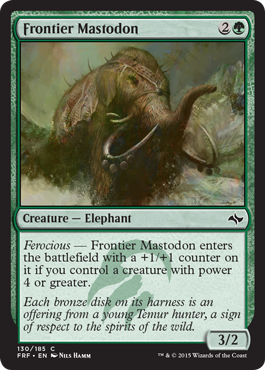
Bigger is better if you're hanging with the Temur, so make sure you pack your deck with enough creatures with power 4 or greater so your ferocious abilities are at full strength. Each ferocious ability is different, but they all rely in some way on controlling a creature with power 4 or greater. It doesn't matter how many creatures with power 4 or greater you control. For example, Frontier Mastodon will enter the battlefield with a +1/+1 counter on it if you control a creature with power 4 or greater. Even if you control ten such creatures, the ability will add only one +1/+1 counter.
Instants and sorceries with ferocious abilities check if you control a creature with power 4 or greater as they resolve. If the ferocious ability says "instead," that effect will replace some or all of the normal effect of that instant or sorcery. If it doesn't say "instead," the effect of the ferocious ability happens in addition to the spell's normal effect.
Some ferocious abilities are activated abilities. If the effect depends on the number of creatures you control with power 4 or greater, that number is counted as the ability resolves. Other abilities require that you control a creature with power 4 or greater to even activate the ability. For those abilities, once you activate the ability, it doesn't matter what happens to the creature with power 4 or greater. Even if it dies in response to the ability, the ability will still resolve.

Manifest
This far back in Tarkir's past, the Spirit Dragon Ugin is very much alive. His magic, rooted in concealment and deception, appears as the new ability manifest.
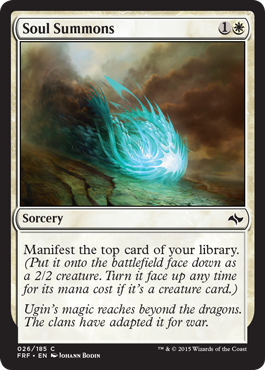

When you manifest a card, you put it onto the battlefield face down. This disguises its true identity from your opponents. While face down, it's a 2/2 colorless creature with no name, no abilities, and no creature types. Face-down creatures are creatures in every way. They can attack and block, and spells and abilities that target creatures can target them. They can be enchanted by Auras and equipped by Equipment.
If you played with cards with morph in the Khans of Tarkir set (or older sets), you're already probably familiar with how face-down creatures work. In fact, manifested cards get their own sweet-looking overlay card to use as a reminder:
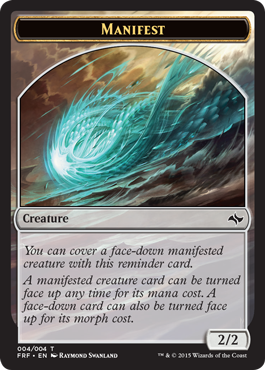
You can put this overlay card on one of your manifested creatures while it's on the battlefield. The overlay is just a reminder. You don't have to use it if you don't want to, and it doesn't change how face-down creatures function.
But, what fun is disguising your card's real identity if you can't later reveal it and surprise your opponent? Any time you have priority, you can turn a manifested creature face up if it's a creature card. You do this by revealing what its mana cost is and paying that cost. This also lets your opponents see that it's a creature card. As soon as the card is face up, it has its normal characteristics. If you manifest a noncreature card, it can't be turned face up this way. If you happen to manifest a card with morph, you can turn it face up either by paying its mana cost (if it's a creature card) or by paying its morph cost.
Turning a face-down creature face up doesn't use the stack and can't be responded to. The timing works out the same way it did with morph, so if you didn't catch the "Mechanics of Khans of Tarkir" article, I recommend checking it out.
If the face-down creature has any counters on it, those remain on the face-up creature. It's not a new creature, and it doesn't enter the battlefield just by turning face up. Any Auras or Equipment attached to the manifested creature remain attached to it after it turns face up. There are three enchantments in Fate Reforged that manifest a card and then become an Aura attached to it.
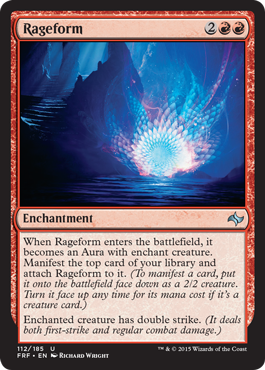
If Rageform leaves the battlefield in response to its triggered ability, you'll still manifest the top card of your library. Once the ability resolves, Rageform is an Aura, so it will be put into the graveyard if the enchanted creature leaves the battlefield.
A few older cards turn a face-down creature face up. If you manifest an instant or sorcery card, and one of these older cards tries to turn it face up, reveal the card and it stays on the battlefield face down.

Hybrid Mana
Several cards in the Fate Reforged set, including the five clan leaders, have abilities that include hybrid mana symbols.
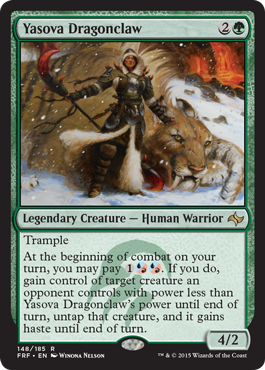
A hybrid mana symbol can be paid with either of two colors of mana. If a cost includes multiple hybrid mana symbols, you can choose a different color to pay for each. For example, when Yasova Dragonclaw's ability resolves, you could pay 1UU, 1UR, or 1RR to gain control of the target creature.

Modal Enters-the-Battlefield Abilities
There's a cycle of creatures that offer you a choice when they enter the battlefield: put a +1/+1 counter on the creature or get some other effect.
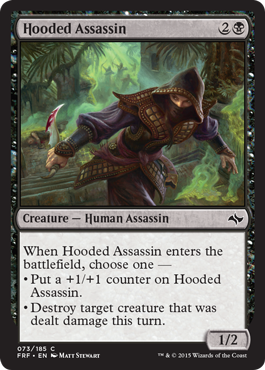
You choose which mode you are using when you put the ability on the stack. Once you choose a mode, you can't change to the other mode no matter what happens before that ability resolves. For example, say Hooded Assassin enters the battlefield and you choose the second mode. You then choose the target, a creature that was dealt damage that turn. In response to that ability, the creature leaves the battlefield. You can't change your mind and put the +1/+1 counter on Hooded Assassin. The ability will just fail to do anything.
Your battles in Tarkir's past may reforge the fate of the entire plane and beyond. Have fun!

